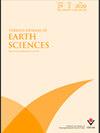Paleoseismology of the Sürgü and Çardak faults - splays of the Eastern Anatolian Fault Zone, Türkiye
IF 1.1
4区 地球科学
Q3 GEOSCIENCES, MULTIDISCIPLINARY
引用次数: 3
Abstract
: The sinistral East Anatolian Fault Zone (EAFZ) and the dextral North Anatolian Fault Zone (NAFZ) are two important strike-slip faults that delimit the boundaries of the Anatolian plate. The north-south directed compressional forces in eastern Türkiye trigger the westward escape of the Anatolian plate along these prominent structures. This study aims to reveal the earthquake history of the Sürgü and Çardak faults, which are important fault segments that splay from the EAFZ. In this context, overall, four paleoseismologic trenches were dug, two trenches on the Sürgü Fault and two trenches on the Çardak Fault. Along the Sürgü Fault, at least two paleoearthquake events have been determined on the trench walls, one event occurred around 3400 BCE and the second event happened between 2085 ± 65 BCE and 790 ± 20 BCE. Moreover, trenching results from the Çardak Fault indicate two surface rupturing paleoearthquakes between 10520 ± 95 BCE and 5780 ± 65 BCE, and between 3215 ± 125 BCE and 825 ± 55 CE, respectively. The focal mechanisms of important instrumental earthquakes around the Sürgü and Çardak faults on the EAFZ show that NNE-SSW trending compressional forces are actively dominating the tectonic setting of the region in the contemporary era. Paleoseismological investigations suggested that the Sürgü and Çardak faults have the potential to produce surface-rupturing earthquakes with an estimated magnitude of 7 or larger.东安纳托利亚断裂带Sürgü和Çardak断裂带的古地震学,[j]
:左旋东安纳托利亚断层带(EAFZ)和右旋北安纳托利亚断裂带(NAFZ)是界定安纳托利亚板块边界的两条重要走滑断层。土耳其东部南北方向的挤压力触发了安纳托利亚板块沿着这些突出结构向西逃离。本研究旨在揭示Sürgü和Çardak断层的地震历史,这两条断层是从EAFZ开始张开的重要断层段。在这种情况下,总共挖掘了四条古地震学海沟,其中两条在Sürgü断层上,两条在Çardak断层上。沿着Sürgü断层,在海沟壁上至少确定了两次古地震事件,一次发生在公元前3400年左右,第二次发生在2085±65至790±20年之间。此外,恰尔达克断层的挖沟结果表明,两次地表破裂古地震分别发生在公元前10520±95和5780±65之间,以及3215±125和825±55之间。EAFZ上Sürgü和Çardak断层周围重要仪器地震的震源机制表明,NNE-SW向挤压力在当代积极主导着该地区的构造环境。古地震学调查表明,Sürgü和Çardak断层有可能产生估计震级为7级或更大的地表破裂地震。
本文章由计算机程序翻译,如有差异,请以英文原文为准。
求助全文
约1分钟内获得全文
求助全文
来源期刊

Turkish Journal of Earth Sciences
地学-地球科学综合
CiteScore
2.40
自引率
10.00%
发文量
6
审稿时长
6 months
期刊介绍:
The Turkish Journal of Earth Sciences is published electronically 6 times a year by the Scientific and Technological Research
Council of Turkey (TÜBİTAK). It is an international English-language journal for the publication of significant original recent
research in a wide spectrum of topics in the earth sciences, such as geology, structural geology, tectonics, sedimentology,
geochemistry, geochronology, paleontology, igneous and metamorphic petrology, mineralogy, biostratigraphy, geophysics,
geomorphology, paleoecology and oceanography, and mineral deposits. Contribution is open to researchers of all nationalities.
 求助内容:
求助内容: 应助结果提醒方式:
应助结果提醒方式:


